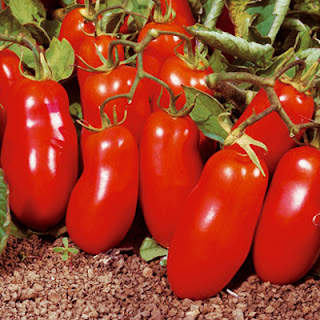An Intro to San Marzano Tomatoes
MY STATUS: Grown Successfully to Harvest
San Marzano are a type of plum tomato with an elongated body and firm flesh used primarily for making tomato paste for sauces. They're similar to Roma tomatoes but are said to have a stronger, sweeter taste. Because they aren't as tender or juicy as the large beefsteak tomatoes, they aren't as desirable for salads and sandwiches. Like all the tomato varieties I've tried to grow here, they are indeterminate, meaning that plants will continue to produce fruit as long as the weather is sufficiently warm--a good choice for Pohnpei's endless summer temperatures. Plants can grow to a height of 6 feet and take 80-90 days to mature. Fruit are about 4 ounces. I used Martha Stewart Living seeds purchased at Home Depot in Southern California in early winter. They were kept in the fridge for about 4 months.SUN, SUN, SUN
I feel like I've said this a lot: successful tomatoes depend on lots and lots of sun. The plants may survive in shade, but they will not produce fruit. One thing I'm still trying to figure out is how to get my tomatoes out in the open where they can get maximum sun and still be protected from rain and wind. Right now they get about 3 hours of direct sun in the afternoon (on a sunny day), which is just not enough. I tried building a PVC structure, but that didn't stand up to the crazy gusts of wind we get here. Now I'm thinking about something constructed of metal or wood.
RAIN PROTECTION
Another statement I've repeated a lot: Keep the tomatoes out of the rain. Depending on how hot and sunny it is, they may need water two or three times a week. More than that and they will develop fungal and/or bacterial infections, rot or drown. Use the four-inch soil test to determine when to water: if the soil is moist at a depth of four inches, do not water.
BUGS
After bacterial and fungal infections, pests are the next biggest threat. Many varieties of worms, beetles, mites, aphids, and whiteflies consider tomato plants scrumptious. As soon as I get a complete verified list of the pests found on Pohnpei, I'll post it on this blog. Hornworms, which are notorious for ravaging tomatoes elsewhere, don't live here. Whiteflies are the most common tomato pest on Pohnpei. So far I haven't found any complete protection. View the whiteflies post for more information.
CROSS-POLLINATION ALERT
If you're growing multiple types of tomatoes at the same time and in close proximity, they can cross-pollinate. This won't affect the current generation of plants in any way, but if you plan to gather seeds from your plants for a second generation, you could end up with some strange unintended hybrids.
CONTAINERS?
My primary worry with the San Marzanos was that the containers won't give them enough room to grow, but with the pig feed bag method, things should be excellent.
What I Did
DAY 1 - SOWING
I planted my seeds in small biodegradable starter pots filled with store-bought garden soil--three 1/2 inch holes and a few seeds in the bottom of each. I covered the seeds, watered the soil, and put the pot in direct sun. A few days after germination, I thinned the seedlings to three. About a week later, I thinned them down to a single plant.DAY 62 - TRANSPLANTATION
Being busy and not playing much attention to these plants, they grew slowly and were quite overlarge by the time I got all the conditions in place for a transplant. Sixty days is a heck of a long time for tomatoes to be in starter pots, but that's okay. The garden can't be priority number one all the time.I was also building a roof-top structure that I could keep my plants (and especially my tomatoes) in, so that they'd get the maximum sun Pohnpei has to offer without being exposed to the rain and wind. the "house" is pretty sweet and has done wonders for all the other plants. I'm crossing my fingers about the tomatoes.

Another thing I wanted to do was adjust my growing strategy for the tomatoes, since the first run failed, in part, because the plants didn't have enough room to expand their root systems. Rather than spend a bunch of money on huge containers, I collected discarded pig feed bags from people around where we live. Every local on Pohnpei has a large supply of these empty feed bags, because everyone grows pigs. The bags are huge, super heavy duty (rip-proof), and are self-supporting when filled with soil. But since I already had 6 gallon pots from the first tomato attempt, I cut the bottoms of my bags off and set them in those pots, then added my gravel layer and soil. This makes them easier to move, when necessary. Each bag took 2 1/2 bags of potting soil, and though they are not much wider than the pots are, they are triple the depth. That will give each plant 3X the vertical room to grow. Once I got some of the sack-containers ready, I did the transplants in the manner described HERE.











.jpg)







0 comments:
Post a Comment